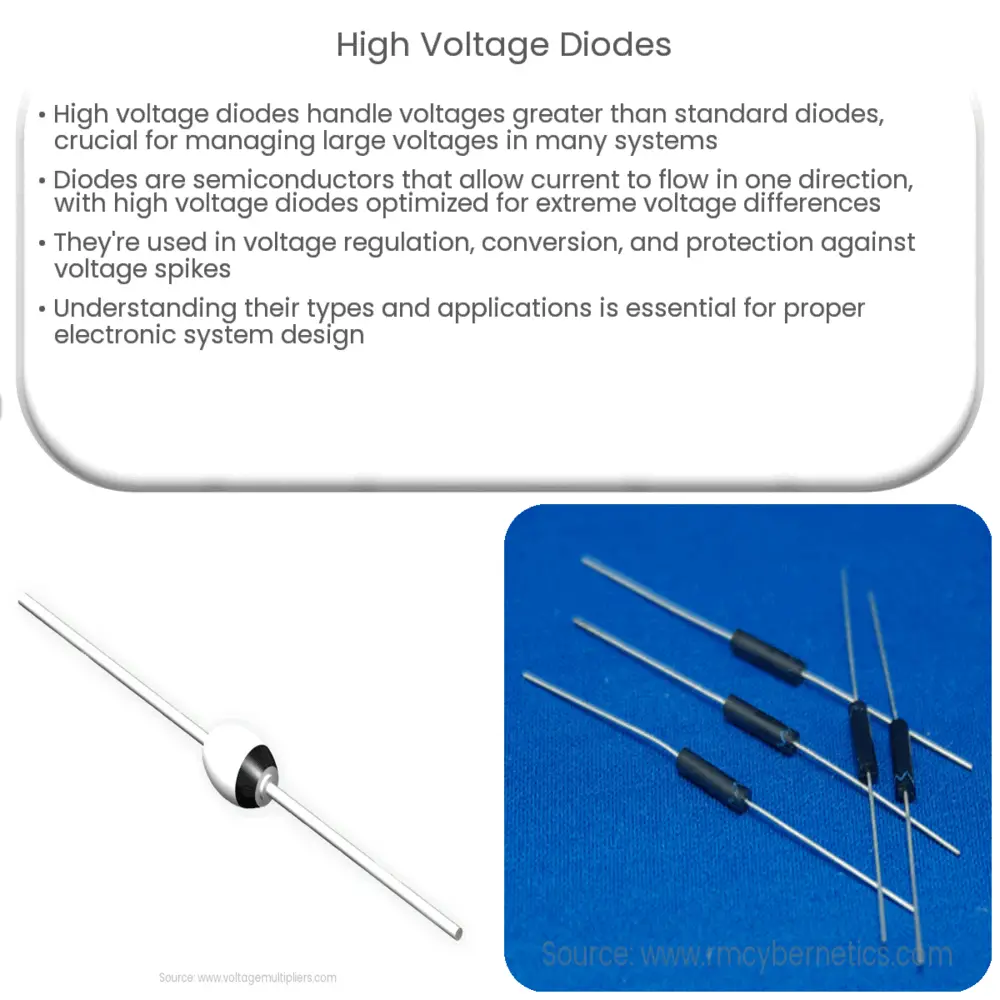Explore the working principle, applications, and types of high voltage diodes, crucial components in electronics and power supply systems.

Introduction to High Voltage Diodes
A high voltage diode is a specialized type of diode designed to handle higher voltage levels than a standard diode. It plays a critical role in many electronic and power supply systems where the management of large voltage is required. The ability of high voltage diodes to tolerate these high voltage conditions makes them invaluable in numerous applications.
Understanding Diodes
Before delving into the specifics of high voltage diodes, it is crucial to understand the function of a basic diode. Essentially, a diode is a semiconductor device with two terminals, allowing the flow of current in only one direction. In more technical terms, a diode is a device that restricts current flow chiefly to one direction by implementing an asymmetrical conductance level.
Working Principle of High Voltage Diodes
The operational principles of high voltage diodes remain similar to standard diodes, yet they are optimized for high voltage conditions. These diodes are designed to handle large voltage differences between the anode (positive side) and cathode (negative side). The higher voltage rating is achieved by designing the diode with a larger cross-sectional area for the electrons and holes to recombine.
- P-N Junction: The core component of a high voltage diode is a ‘P-N junction’. The ‘P’ side consists of positively charged ‘holes’, while the ‘N’ side is packed with negatively charged electrons. When the diode is connected in the forward direction, the electrons meet the holes at the junction, causing current flow.
- Reverse Biasing: On the contrary, if the diode is connected in the reverse direction, the electrons and holes move apart, creating a ‘depletion region’ that prevents current flow. However, when the voltage exceeds a certain limit (known as the breakdown voltage), the diode conducts in the reverse direction. High voltage diodes have a higher breakdown voltage.
Applications of High Voltage Diodes
Due to their ability to handle high voltage, these diodes are used in various applications. These applications are typically where voltage regulation and conversion are necessary, such as in power supply circuits, voltage multipliers, and X-ray machines. A high voltage diode can also be used in protecting circuits from voltage spikes.
Notable Types of High Voltage Diodes
In the realm of high voltage diodes, several types stand out due to their specialized properties and uses. Here are some notable types:
- Rectifier Diodes: These are perhaps the most common type of high voltage diodes. Rectifier diodes are designed to convert alternating current (AC) to direct current (DC). They can handle high voltage and are thus extensively used in power supply units.
- Zener Diodes: A Zener diode can not only block current in the reverse direction like a standard diode, but when the reverse bias voltage exceeds the Zener voltage, it allows the current to flow in the reverse direction. Zener diodes are therefore primarily used for voltage regulation.
- Switching Diodes: High voltage switching diodes are designed for high-speed switching applications. They offer very fast reverse recovery times, making them ideal for use in high-frequency circuits.
Considerations when Choosing High Voltage Diodes
When choosing high voltage diodes for a specific application, several factors must be considered. The diode must have a maximum repetitive reverse voltage (VRRM) rating that can safely handle the maximum voltage in the application. Additionally, the maximum forward current (IF), maximum surge current (IFSM), and reverse recovery time (trr) ratings should be adequate for the application. Finally, the physical size and mounting method of the diode may be important, especially in space-constrained applications.
Conclusion
In conclusion, high voltage diodes play a significant role in electronic and power supply systems. They offer a host of benefits including the ability to handle high voltage, perform voltage regulation, and enable high-speed switching. Understanding the different types of high voltage diodes and their applications is crucial in order to select the right diode for a specific use case. As technologies continue to evolve, the role of high voltage diodes will likely remain indispensable in numerous areas of electronics.

